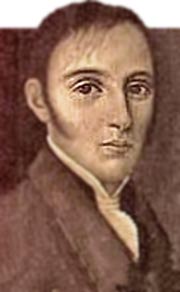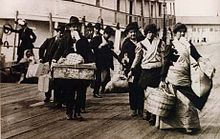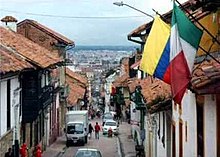This is an old revision of this page, as edited by Juan david zapta (talk | contribs) at 19:59, 6 July 2023 (Approximate percentage of Italian origin in Colombia compared to its current population. Its influence is visible in many surnames, typical dishes, places of interest, important people and so companies founded by Italian Colombians). The present address (URL) is a permanent link to this revision, which may differ significantly from the current revision.
Revision as of 19:59, 6 July 2023 by Juan david zapta (talk | contribs) (Approximate percentage of Italian origin in Colombia compared to its current population. Its influence is visible in many surnames, typical dishes, places of interest, important people and so companies founded by Italian Colombians)(diff) ← Previous revision | Latest revision (diff) | Newer revision → (diff) Colombian citizens of Italian descent Ethnic groupItalian Colombians (Template:Lang-it; Template:Lang-es) are Colombian-born citizens who are fully or partially of Italian descent, whose ancestors were Italians who emigrated to Colombia during the Italian diaspora, or Italian-born people in Colombia. Italians have been immigrating to Colombia since the early 16th century.
History
Colonial period
The presence of Italians in Colombia began from the times of Christopher Columbus and Amerigo Vespucci. The very name of Colombia comes from the discoverer of America, idealized by the Venezuelan Francisco de Miranda.
Martino Galeano (member of the noble Galeano Family of Genoa) was one of the most important conquerors of the territory of present-day Colombia (New Kingdom of Granada). As an infantry captain, he directed the military campaign of Pedro Fernández de Lugo, who landed in Santa Marta in 1535. He later founded the town of Vélez, in Santander, being its alderman and co-founder of Bogotá.
In the 18th century, on the ship Santa Rosa, the naval artilleryman Giovanni Andrea Botero arrived from the port of Cádiz to the city of Cartagena de Indias, specifically in January 1716, working in the service of the Spanish crown. The artilleryman Botero was born in the Republic of Genoa and due to illness he had to ask permission, not being Spaniard, to stay in the territory of the Viceroyalty of New Granada. He traveled to the interior of the country and settled in the municipality of Rionegro, Valley of San Nicolás, Antioquia, where he devoted himself to agriculture and gold mining, founding this family in Colombia there.
Independent Colombia

Very few Italians arrived in Colombia before the war of independence led by Simón Bolívar, although several hundred monks came from Italy primarily as priests and missionaries were present in the country.
They have left their mark in many lines of the colombian colonial society.
Although few, these early Italians were present in almost all higher levels of Colombian society, like Juan Dionisio Gamba, the son of a merchant from Genoa who was president of Colombia in 1812.

....The Italian influence in Colombia was important in science, culture, arts and laws. Furthermore, they created symbols like the country map, the National Hymn and the Capitol.(La influencia italiana fue determinante en la ciencia, la cultura, las artes y el derecho de Colombia. Además, les dieron vida a símbolos como el mapa, el Himno Nacional y el Capitolio.)
— Armando Silva
In the mid-nineteenth century, many Italians arrived from South Italy (especially from the province of Salerno, and the areas of Basilicata and Calabria), arrived on the north coast of Colombia: Barranquilla was the first center affected by this mass migration.
One of the first complete maps of Colombia, adopted today with some modifications, was prepared earlier by another Italian, Agustino Codazzi, who arrived in Bogota in 1849. The Colonel Agustin Codazzi also proposed the establishment of an agricultural colony of Italians, on model of what was done with the Colonia Tovar in Venezuela, but some factors prevented it.

In 1885 diplomatic relations for some years between Italy and Colombia were interrupted. When a wealthy businessman in the Italian-Colombian Cauca named Ernesto Cerruti- was placed against the oligarchy and the church favoring a liberal party and local mason, Bogota authorities confiscated their property and imprisoned. This has caused a blockade of the port by the Colombian Navy and Italian emigration in Italy was partially closed until 1899.
In November 1887 to commemorate the independence of Cartagena, has been interpreted in Bogota Variety Theatre, a fervent song with lyrics (by Rafael Núñez) which was subsequently adopted by the Law 1920 as Hymn of the Republic of Colombia: his charm and melody came from someone who had arrived as first tenor in an opera company, the Italian musician Oreste Sindici (May 31, 1828 – January 12, 1904), and who lived the last years of his life in Bogotá well acclaimed by the Colombians.
Oreste Sindici was an Italian-born Colombian musician and composer, who composed the music for the Colombian national anthem in 1887. Oreste Sindici died in Bogotá on January 12, 1904, due to severe arteriosclerosis. In 1937 the Colombian government honored his memory.

Some important buildings were created by Italians in the 19th century, like the famous Colón Theater of the capital. It is one of the most representative theatres of Colombia, with a neoclassic architecture: was built by the Italian architect Pietro Cantini and founded in 1892; has more than 2,400 square metres (26,000 sq ft) for 900 people. This famous Italian architect also contributed to the construction of the Capitolio Nacional of the capital.
The sculptor Cesare Sighinolfi travelled to Bogotà, Colombia in 1880, invited by his mentor Pietro Cantini to help decorate the Teatro Cristobal Colon. He made monuments to Christopher Columbus and Isabelle the Catholic (1906). In Bogota, Cesare Sighinolfi succeeded Alberto Urdaneta, as director of the "School of Fine Arts of Bogotá": teaching alongside Luigi Ramelli and Pietro Cantini. In 1896, in Bogota he completed a portrait of Rafael Reyes.
In 1908 -according to the relation of the diplomat Agnoli to the Italian Commissary for Emigration- in Colombia there were nearly one thousand Italians: 400 in Barranquilla, 120 in Bogota, less than 100 in Cartagena and Bucaramanga, while only a few dozens lived in Cucuta and other minor cities. Most of the Italians were from Veneto and Tuscany; their main activity was in commerce and restaurants/hotels but 30 Italians owned huge lands and successfully cultivated with farms.
World War II
After the Second World War, Italian emigration to Colombia was directed primarily toward Bogota, Cali and Medellin. Italian immigrants in Colombia are mainly concentrated in the capital region (and secondarily in Cali & Medellin). They have Italian schools in Bogota (Institutes "Leonardo da Vinci" and "Alessandro Volta"), Medellín ("Leonardo da Vinci") & Barranquilla ("Galileo Galilei").
Furthermore, there are some institutions promoted by the Italian government, like the "Sociedad Dante Alighieri", the "Instituto de Cultura italiana" and the "Casa de Italia" in the capital.
Italian immigration to Colombia
There are 20,315 Italians in 2019 (by citizenship) that reside in Colombia. And about 2,000,000 Italian descents of full or partial ancestry, corresponding to about 4% of the total population.

Language
Italian immigrants have integrated easily into Colombian society. Today the vast majority of their descendants only speak Spanish, the national language of Colombia. Approximately 4.3% of the natives still speak (or understand a little) the Italian in 2008. In the last century here has been an influence of the Italian language in some Colombian words.
Cuisine
Italians brought new recipes and types of food to Colombia but also helped in the development of Colombian's cuisine. Spaghetti and pizza are some of the favorite foods in actual Colombia thanks to them.
Like in many other countries, the Italian cuisine is widely popular in most cities and many municipalities of Colombia.
Notable Italian-born people and descendants

Architecture
- Giovanni Buscaglione, architect
- Giancarlo Mazzanti, architect
Arts and Entertainment
- Rodolfo Aicardi, singer
- Fernando Botero, draftsman, painter and sculptor
- María Cecilia Botero, actress and TV presenter
- María Dalmazzo, actress
- Shakira Mebarak Ripoll, singer-songwriter and businesswoman
- Andrea Nocetti, model, actress and Miss Colombia 2000
- Taliana Vargas, model, actress and Miss Colombia 2007 (1st runner up Miss Universe 2008)

Colombian history
- Agustín Codazzi, geographer
- Oreste Sindici, musician and composer
Politics
- Armando Benedetti, politician
- Gustavo Petro, politician (President of Colombia 2022-2026)
- Fabio Valencia Cossio, politician
Religion
- Tulio Botero, ecclesiastic of the Catholic Church
- Javier de Nicoló, priest and educator
- Mario Revollo Bravo, ecclesiastic of the Catholic Church
Sports
- Nicolás Benedetti, professional footballer
- Santiago Botero, professional cyclist
- Francisco Cassiani, professional footballer
- Geovanis Cassiani, professional footballer
- Luis Fernando Centi, professional footballer
- Norberto Peluffo, professional footballer, coach and sports commentator
- Eddie Salcedo, professional footballer
Others
- Valeria Ayos Bossa, Miss Universe Colombia 2021
- Daniella Álvarez, Miss Colombia 2011
- Salvatore Mancuso, former member of the AUC
See also
- Colombia–Italy relations
- List of Italian explorers
- List of Italian inventors
- Italians
- White Colombians
- White Latin Americans
References
- ^ Fondazione Migrantes (2019). "Rapporto Italiani nel Mondo" (PDF) (in Italian). pp. 24–25. Retrieved 21 May 2021.
- "Convenzioni Inps estere, Fedi sollecita Nuova Zelanda ma anche Cile e Filippine". www.ilmondo.tv. Archived from the original on 9 February 2018. Retrieved 12 January 2022.
- "RTVCPlay". www.rtvcplay.co. Retrieved 2022-07-13.
- Vidal Ortega, Antonino; D'Amato Castillo, Giuseppe (2015-12-01). "Los otros, sin patria: italianos en el litoral Caribe de Colombia a comienzos del siglo XX". Caravelle. Cahiers du monde hispanique et luso-brésilien (in French) (105): 153–175. doi:10.4000/caravelle.1822. ISSN 1147-6753.
- "Presencia italiana en Norte de Santander". Sílaba Editores (in Spanish). 2021-03-02. Retrieved 2022-07-13.
- Patiño, Paola (2016-11-12). "Los inmigrantes que cambiaron los apellidos en Santander". www.vanguardia.com (in Spanish). Retrieved 2022-07-13.
- "Llegaron los inmigrantes italianos: sesenta novios para otras tantas caleñas". La Bernardi (in Spanish). 2020-10-15. Retrieved 2022-07-13.
- Maturana, Yonatan Durán (2021-01-01). "Casos de inmigrantes italianos en Antioquia, 1870-1900". Studi Emigrazione.
- "Fusagasugá, el campo de concentración de Colombia para alemanes y japoneses durante la Segunda Guerra Mundial". BBC News Mundo (in Spanish). Retrieved 2022-07-13.
- Rojas Velasco, Manuel José (13 July 2022). "Narrativas partidistas sobre inmigrantes: Colombia a mediados del siglo XIX" (PDF). Repositorio.uniandes.edu.co.
- "Un italiano en tierra cafetera en los años 20 (1 parte)". La Bernardi (in Spanish). 2020-06-24. Retrieved 2022-11-08.
- "91.1A.1 Apellidos regionales de Colombia by Academia Colombiana de Genealogia - Issuu". issuu.com. Retrieved 2022-11-08.
- "Noticia sobre los fundadores de los apellidos en el Cauca Grande". 1library.co (in Mexican Spanish). Retrieved 2022-11-08.
- A game of mirrors: the changing face of ethno-racial constructs and language in the Americas. Thomas M. Stephens. University Press of America, 2003. ISBN 0-7618-2638-6, ISBN 978-0-7618-2638-5. Retrieved on 2010-10-14.
- "Los italianos (The Italians)". Revista Semana - www.semana.com (in Spanish). Publicaciones Semana S.A. 28 October 2006. Retrieved 26 March 2022.
- "Los italianos (The Italians)". Revista Semana - www.semana.com (in Spanish). Publicaciones Semana S.A. 28 October 2006. Retrieved 26 March 2022.
- "Pasado, Presente y Futuro (Past, Present and Future)". Alcaldía de Vélez, Santander - www.velez-santander.gov.co (in Spanish). Vélez, Santander, Colombia: Gobierno de Colombia. Retrieved 26 March 2022.
- Ettore, Rossoni (2013). Origine E Storia Dei Cognomi Italiani (Origin And History Of Italian Surnames) (PDF) (in Italian). Melegnano. p. 381. Retrieved 26 March 2022.
- Álvarez Ángel, Flavio (12 October 2018). Apellidos regionales de Colombia (Regional surnames of Colombia) (in Spanish). Bogota, Colombia: Colombian Academy of Genealogy. p. 33. Retrieved 26 March 2022.
- D'Angelo, Giuseppe (1969). Italianismos en Hispanoamérica y particularmente en Colombia (PDF) (in Spanish). Centro Virtual Cervantes. Retrieved 26 March 2022.
- "Juan Dionisio Gamba". Busca Biografías - www.buscabiografias.com (in Spanish). Retrieved 26 March 2022.
- Armando Silva. "Cultura italiana en Colombia: reflexión sobre etnias y mestizajes culturales".Introduccion
- Cappelli, Vittorio (2006). "Entre "Macondo" y Barranquilla. Los italianos en la Colombia caribeña. De finales del Siglo XIX hasta la Segunda Guerra Mundial*" (PDF). Memoria & Sociedad (in Spanish). Archived from the original (PDF) on 2011-07-28. Retrieved 26 March 2022.
- Tomás Fernández; Elena Tamaro (2004). "Biografia de Agustín Codazzi (Biography of Agustín Codazzi)". Biografías y Vidas. La enciclopedia biográfica en línea (in Spanish). Barcelona, Spain. Retrieved 26 March 2022.
- Massimiliano Castellari; Marco Mellone. "La emigración italiana en suramérica y específicamente en Colombia". vLex.com (in Spanish). Retrieved 26 March 2022.
- "Colombian National Anthem, music, lyrics and video". Colombia-SA - www.colombia-sa.com. Retrieved 26 March 2022.
- "Símbolos patrios de Colombia" (in Spanish). Presidencia de Colombia. Archived from the original on March 9, 2012. Retrieved November 1, 2010.
- "Pietro Cantini - Italia -1847-1929". EPDLP - www.epdlp.com (in Spanish). epdlp. Retrieved 26 March 2022.
- Castro Arias, Carlos (11 June 2021). "MinCultura retiró esculturas de Isabel La Católica y Cristóbal Colón". Caracol Radio - www.caracol.com.co (in Spanish). Colombia. Retrieved 26 March 2022.
- "Escuela de Bellas Artes en Colombia". International Center for the Arts of the Americas - www.icaa.mfah.org (in Spanish). Houston, United States of America: MFAH ICAA. Retrieved 26 March 2022.
- Colombia - p.363
- Torres Jiménez, Camilo (6 October 2021). "Educación a la Italiana en Bogotá (Italian-style education in Bogotá)". ITBogotá - www.bogota.italiani.it (in Spanish). Bogotá, Colombia. Retrieved 26 March 2022.
- "Instituciones y Escuelas italianas en Colombia (in Italian)" (PDF). Archived from the original (PDF) on 2012-03-09. Retrieved 2019-04-03.
- "Convenzioni Inps estere, Fedi sollecita Nuova Zelanda ma anche Cile e Filippine". 2018-02-09. Archived from the original on 2018-02-09. Retrieved 2021-08-17.
- Italian words in the Spanish Colombian language
- Solarte, Andrés (27 October 2015). "Italia - Colombia (Gastronomía Típica)". Prezi - www.prezi.com (in Spanish). Retrieved 26 March 2022.
- Escamilla, Oscar (23 December 2018). "La familia une comida de Italia y Colombia". Ansa Latina - Agencia Italiana de Noticias (in Spanish). Bogotá, Colombia: ANSA. Retrieved 26 March 2022.
- Dixon Acosta (24 April 2022). "Pietrasanta y la huella de Botero (Pietrasanta and the footprint of Botero)". Periódico El Espectador - www.elespectador.com (in Spanish). Bogotá, Colombia: Comunican S.A. Retrieved 9 July 2022.
- "Shakira descendiente de italianos, españoles y libaneses". My Heritage (in Spanish). 23 June 2010. Retrieved 25 March 2022.
| Africa |  | |
|---|---|---|
| Americas | ||
| Asia | ||
| Europe | ||
| Oceania | ||
| Exodus | ||
| Neighborhoods | ||
| local ethnic Italians ancient Italian migrations former Italian colonies or protectorates | ||
